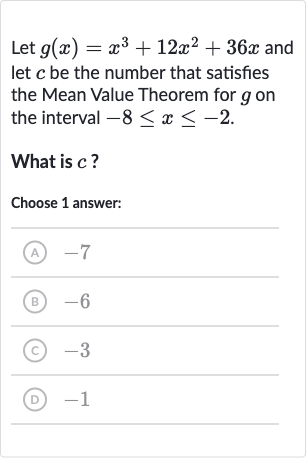AI tutor
Welcome to Bytelearn!
Let’s check out your problem:

Let and let be the number that satisfies the Mean Value Theorem for on the interval .What is ?Choose answer:(A) (B) (C) (D)
Full solution
Q. Let and let be the number that satisfies the Mean Value Theorem for on the interval .What is ?Choose answer:(A) (B) (C) (D)
- Mean Value Theorem Explanation: The Mean Value Theorem states that if a function is continuous on the closed interval and differentiable on the open interval , then there exists at least one number in the interval such that is equal to the average rate of change of the function over . The average rate of change is given by .
- Calculate and : First, we need to find and to calculate the average rate of change of on the interval .
- Calculate Average Rate of Change: Now, we calculate the average rate of change of on the interval .
Average rate of change = - Find Derivative : Next, we need to find , the derivative of , to find the value of that satisfies average rate of change.
- Solve for : We set equal to the average rate of change and solve for .This is a quadratic equation in the form of .
- Quadratic Equation Solution: We can solve the quadratic equation by factoring or using the quadratic formula. Since the equation is already factored as , we can factor further to find the roots.
- Final Value of c: Setting each factor equal to zero gives us the potential values for c. or or
- Final Value of : Setting each factor equal to zero gives us the potential values for .
or
or However, must be in the open interval , so cannot be . Therefore, the only value that satisfies the Mean Value Theorem in the given interval is .
More problems from Euler's method
QuestionGet tutor help
QuestionGet tutor help
QuestionGet tutor help
QuestionGet tutor help
QuestionGet tutor help
QuestionGet tutor help
QuestionGet tutor help
QuestionGet tutor help
QuestionGet tutor help
